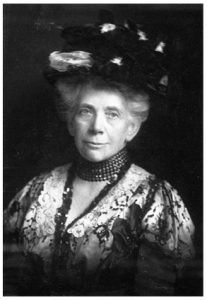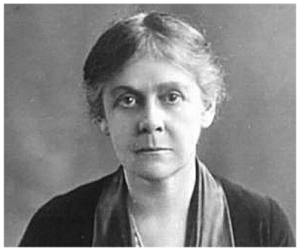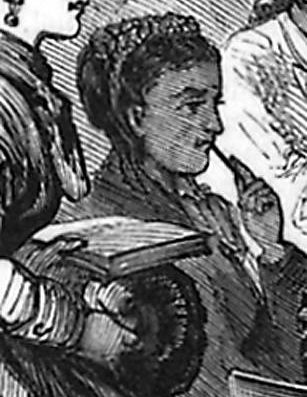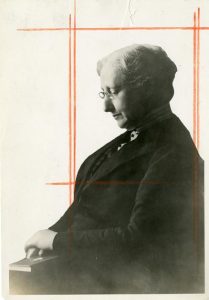This Month in Science and Medicine History – March 2025
by Leigh Ann Gardner (MSTP Senior Grants Manager)
Note on Women’s History Month: The first celebration of Women’s History Month occurred in Santa Rosa, California in 1978. In 1980, President Jimmy Carter issued the first presidential proclamation declaring the week of March 8th as National Women’s History Week. In 1987, Congress passed a resolution designating the month of March as Women’s History Month. You can find additional resources and exhibits about Women’s History Month here.

Week 1 (March 5): Christine Ladd-Franklin, the first American woman to receive graduate instruction in mathematics and symbolic logic, died on March 5, 1930. Born in 1847 in Connecticut, she enrolled in Vassar College in 1866 as a member of the second entering class. However, her financial situation forced her to leave Vassar after her first year, and she returned to teaching at that time to support herself. She returned to Vassar in 1868 and graduated in 1869. She then spent most of the next decade teaching science and math. In 1878, she was accepted to study with James Sylvester at Johns Hopkins University, primarily because the university did not realize that she was a woman. The university attempted to revoke her entrance, but Sylvester pled her case, and she was initially allowed to take only his classes. Although she completed all the PhD requirements for mathematics and logic, she was not granted a degree until 1926. After she completed her studies, she attempted to teach and research at universities; she was often allowed to teach 1 course per semester but without pay and without faculty privileges. She is best known for her research on vision with psychologist G.E. Müller, and she developed her own theory on color vision. She became the first woman member of both the American Psychological Association and Optica (formerly the Optical Society of America). You can learn more about Ladd-Franklin here and you can read one of her publications, “On the Algebra of Logic” here.

Week 2 (March 10): Pathologist and anatomist Lydia DeWitt died on March 10, 1928. Born in Michigan in 1859, she studied at the Michigan State Normal School and married Alton DeWitt in 1878. Lydia taught in public schools throughout Michigan until she entered medical school at the University of Michigan in 1895. After obtaining her MD in 1898, she became an assistant professor of histology at the University of Michigan. She later studied at the University of Berlin, and in 1910, began working for the St. Louis Department of Health as a pathologist. In 1912, her research on chemotherapy for tuberculosis led to the University of Chicago inviting her to join the faculty and research pathology there. Her research focused on a variety of topics, including the pathology of tuberculosis, esophageal anatomy, and the anatomy of connections within mammalian hearts. At the University of Chicago, she led a team working on developing a drug to treat tuberculosis; although her research did not immediately work, her methods were eventually used to develop a chemotherapy for tuberculosis and as a model for other drug development. You can learn more about DeWitt here and here.

Week 3 (March 16): Born on March 16, 1846, in Philadelphia, Rebecca J. Cole was the 2nd African American woman to become a physician in the United States. Cole graduated from the Woman’s Medical College of Pennsylvania, the first school to offer formal medical training to women, in 1867. Following graduation, she worked for Dr. Elizabeth Blackwell’s New York Infirmary for Women and Children. Details of her career are scarce, but it is believed she later practiced medicine in South Carolina before returning to Philadelphia to open the Women’s Directory Center in 1873. This center offered both medical and legal services to women and children. In 1899, she became superintendent of a home established by the Association for the Relief of Destitute Colored Women and Children. Cole died in 1922, and you can learn more about her here.

Week 4 (March 26): Psychologist Lillien Jane Martin, known for her work on gerontology, died on March 26, 1943. Born in New York in 1851, Martin attended Vassar College, where she graduated in 1880. She then worked as a high school science teacher in Indianapolis and San Francisco. She retired from teaching in 1894 and studied psychology at the University of Gottingen in Germany, becoming the second woman allowed to study in that program. She trained as an experimental psychologist and became the assistant of G.E. Müller. Martin studied at Gottingen until 1898 but did not receive a degree until 1913, when the Psychological Institute of Bonn awarded her an honorary doctorate. In 1899, she was invited to join the psychology faculty at Stanford University, where she remained and researched until 1916. In 1920, she opened the first mental hygiene clinic for children and worked as a clinical psychologist. In 1929, she pivoted her career again, opening the Old Age Center, the first counseling center for senior citizens. During the 1930s, she was regarded as an international authority on gerontology. Martin died in 1943, and you can learn more about her here.
Please acknowledge the Vanderbilt University MSTP if you share this information.
